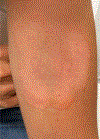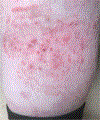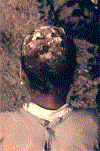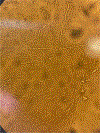Expert Panel Review of Skin and Hair Dermatophytoses in an Era of Antifungal Resistance
- PMID: 38494575
- PMCID: PMC11201321
- DOI: 10.1007/s40257-024-00848-1
Expert Panel Review of Skin and Hair Dermatophytoses in an Era of Antifungal Resistance
Abstract
Dermatophytoses are fungal infections of the skin, hair, and nails that affect approximately 25% of the global population. Occlusive clothing, living in a hot humid environment, poor hygiene, proximity to animals, and crowded living conditions are important risk factors. Dermatophyte infections are named for the anatomic area they infect, and include tinea corporis, cruris, capitis, barbae, faciei, pedis, and manuum. Tinea incognito describes steroid-modified tinea. In some patients, especially those who are immunosuppressed or who have a history of corticosteroid use, dermatophyte infections may spread to involve extensive skin areas, and, in rare cases, may extend to the dermis and hair follicle. Over the past decade, dermatophytoses cases not responding to standard of care therapy have been increasingly reported. These cases are especially prevalent in the Indian subcontinent, and Trichophyton indotineae has been identified as the causative species, generating concern regarding resistance to available antifungal therapies. Antifungal-resistant dermatophyte infections have been recently recognized in the United States. Antifungal resistance is now a global health concern. When feasible, mycological confirmation before starting treatment is considered best practice. To curb antifungal-resistant infections, it is necessary for physicians to maintain a high index of suspicion for resistant dermatophyte infections coupled with antifungal stewardship efforts. Furthermore, by forging partnerships with federal agencies, state and local public health agencies, professional societies, and academic institutions, dermatologists can lead efforts to prevent the spread of antifungal-resistant dermatophytes.
© 2024. The Author(s), under exclusive licence to Springer Nature Switzerland AG.
Conflict of interest statement
Figures















Similar articles
-
Antifungal resistance in dermatophytes - review of the epidemiology, diagnostic challenges and treatment strategies for managing Trichophyton indotineae infections.Expert Rev Anti Infect Ther. 2024 Sep;22(9):739-751. doi: 10.1080/14787210.2024.2390629. Epub 2024 Aug 18. Expert Rev Anti Infect Ther. 2024. PMID: 39114868 Review.
-
Treatment and diagnostic challenges associated with the novel and rapidly emerging antifungal-resistant dermatophyte, Trichophyton indotineae.J Clin Microbiol. 2025 Jun 11;63(6):e0140724. doi: 10.1128/jcm.01407-24. Epub 2025 Jun 11. J Clin Microbiol. 2025. PMID: 40497720 Free PMC article. Review.
-
[Persistent dermatomycosis due toTrichophyton indotineae].Ned Tijdschr Geneeskd. 2024 Jul 23;168:D7945. Ned Tijdschr Geneeskd. 2024. PMID: 39087461 Dutch.
-
Dermatophytes: Update on Clinical Epidemiology and Treatment.Mycopathologia. 2024 Nov 21;189(6):101. doi: 10.1007/s11046-024-00909-3. Mycopathologia. 2024. PMID: 39567411 Review.
-
Chinese expert consensus on management of antifungal-resistant dermatophytoses (2024 edition).Mycoses. 2024 Sep;67(9):e13785. doi: 10.1111/myc.13785. Mycoses. 2024. PMID: 39245647
Cited by
-
Navigating the fungal battlefield: cysteine-rich antifungal proteins and peptides from Eurotiales.Front Fungal Biol. 2024 Sep 3;5:1451455. doi: 10.3389/ffunb.2024.1451455. eCollection 2024. Front Fungal Biol. 2024. PMID: 39323611 Free PMC article. Review.
-
Cutaneous Infections Caused by Trichophyton indotineae: Case Series and Systematic Review.J Clin Med. 2025 Feb 14;14(4):1280. doi: 10.3390/jcm14041280. J Clin Med. 2025. PMID: 40004809 Free PMC article. Review.
-
Trend analysis and cross nations inequality analysis of infectious skin diseases from 1990 to 2021.Arch Dermatol Res. 2025 Jan 8;317(1):203. doi: 10.1007/s00403-024-03757-9. Arch Dermatol Res. 2025. PMID: 39775948
-
Scratching the surface: The rise of antifungal-resistant dermatophytes.Clin Microbiol Newsl. 2025 Jun;51:26-30. doi: 10.1016/j.clinmicnews.2025.04.003. Clin Microbiol Newsl. 2025. PMID: 40520827 Free PMC article.
-
A systematic analysis of the global, regional, and national burden of fungal skin diseases from 1990 to 2021.Front Epidemiol. 2024 Dec 16;4:1489148. doi: 10.3389/fepid.2024.1489148. eCollection 2024. Front Epidemiol. 2024. PMID: 39741899 Free PMC article.
References
-
- Hainer BL. Dermatophyte infections. Am Fam Physician. 2003;67(1):101–8. - PubMed
Publication types
MeSH terms
Substances
Grants and funding
LinkOut - more resources
Full Text Sources
Medical
Miscellaneous

